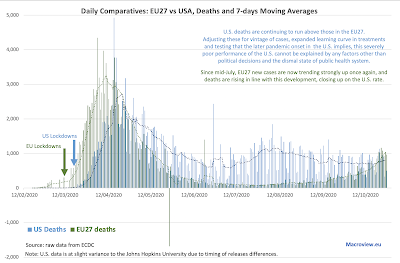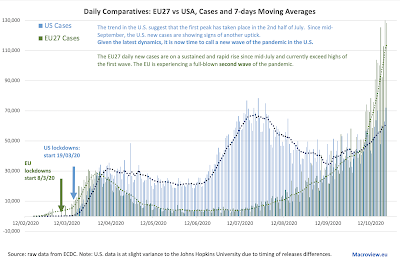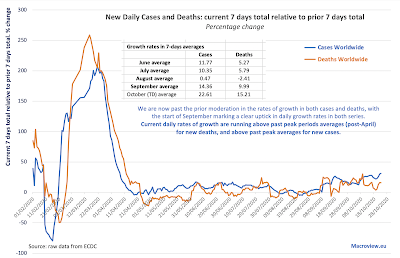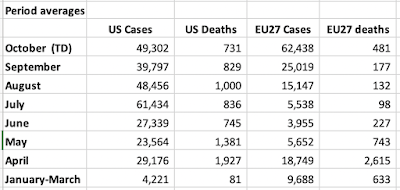I have been running EU vs U.S. comparatives for COVID19 pandemic dynamics for some time now, and as those reading this blog would know, some months ago I added an estimate - based on mortality figures - of the excess U.S. deaths compared to the EU27. These currently - by my estimate - stand at 114,621 (see latest estimate here: https://trueeconomics.blogspot.com/2020/10/231020-covid19-update-us-vs-eu27.html).
My estimate is crude. It is based on timings, population size and mortality rate adjustments.
A more accurate recent estimate has been provided by the Columbia University study (https://resiliencesystem.org/columbia-university-says-trump-could-have-avoided-over-130000-covid-19-deaths-more-robust-pandemic) that puts the number at 130,000-210,000 'avoidable deaths'. That is some range, of course. Per study: "If "the U.S. had followed Canadian policies and protocols, there might have only been 85,192 U.S. deaths – making more than 132,500 American deaths 'avoidable,'" the authors wrote. "If the U.S. response had mirrored that of Germany, the U.S. may have only had 38,457 deaths – leaving 179,260 avoidable deaths."
One way or the other, there are at least 100,000+ Americans dead because of the completely shambolic public health system and policy responses by the current Federal and State leaderships in the U.S.
Columbia study seems to nail some of these factors: "The country's disproportionate death toll stems from delayed federal action, an insufficient testing regimen, a lack of consistent mask-wearing guidance, and the failure of top officials, notably Trump, to model best practices". Alas, predictably (mythology of the American culture), it misses the elephant in the room: the U.S. healthcare system itself. American approach to distributing access to healthcare based on private insurance (plus Medicare and Medicaid) is leaving tens of millions of Americans outside the basic safety net. Those without insurance as well as countless more with the atrociously large deductibles and co-pays are too afraid to present themselves to the hospitals designed to bankrupt people of modest means to seek early support and help. It matters little how much the U.S. authorities test the public (and, yes, tests are highly rationed, still, despite all the bluster from the White House), if people do not seek help in fear of being destroyed financially.
In 2020, the average annual deductible for single, individual coverage is $4,364 and $8,439 for family coverage. Co-pay normally ranges 10-40% of the bill, though it is more complicated, since there are various caps and step-downs in co-payments. (https://www.ehealthinsurance.com/resources/individual-and-family/how-much-does-individual-health-insurance-cost#:~:text=Deductibles%20and%20cost%2Dsharing%20expenses,and%20%248%2C439%20for%20family%20coverage.)
The typical American household has an average of $8,863 in a bank or credit union account. There are serious variations by age and type of household, with couples 34 and younger, couples without children have an average of $4,727 in savings, while single people without children have an average of $2,729 in savings. Couples with children between the age of 35 and 44 have an average of $10,399, couples aged 45-54 with children average $15,589. (https://www.cnbc.com/2019/03/11/how-much-money-americans-have-in-their-savings-accounts-at-every-age.html)
Meanwhile, the median charge for COVID-19 inpatient care was $45,683 for people aged 51 to 60 and $34,662 for those in the 23 to 30 age bracket, according to a recent study. This was the median billed to people without insurance or those who were forced to be treated out of network. The highest average allowed amount paid to the provider under an insurance plan was $24,012 for people aged 51 to 60 and, at its lowest, $17,094 for people above age 70. (https://www.thehealthcareloop.com/hospitalized-care-for-covid-19-averages-34662-to-45683-varying-by-age/)
So a person visit for COVID19 treatment, counting lost wages, would wipe out between 1/2 and all of the savings held by average household. Contagion within the family would be a near insolvency event.
Anyone surprised American system is killing the U.S. citizens and residents?

















































